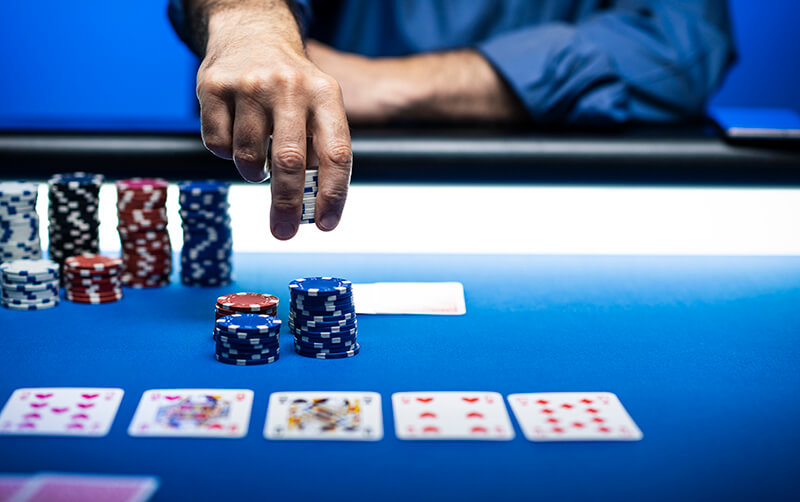Check Raise Poker Meaning
Posted : admin On 4/6/2022- A poker check-raise consists of checking when the action’s on you, and then raising after a player behind you has bet. Essentially it’s a trapping move, putting pressure on your opponents. This is utilized for two reasons: 1) Check-raising for value, meaning you want to get more into the pot, or 2) by bluffing you can force an opponent to.
- What is Check in Poker? A check means that the action passes to the player on our left without us making any wager. Checking is only possible when no-one has made a bet on the current street. Say, for instance, a bet has been made before us on the current street, our options are to call, raise or fold.
- Check-Raising Done Right. Since this is a beginner poker strategy series, moves like the check-raise must be handled with care. While the check-raise is definitely an essential move and deserves a spot in every poker player’s toolbox, if you start firing off check-raises willy nilly it’s only going to get you into trouble.
A check raise is a declaration of strength, but it's one that most players will question, meaning it's up to you to break out your best poker face for the play. Be conscious of any tells you may have, such as shaky palms, excessive talking or darting eyes, as they are surefire signs of weakness. The check-raise is an important move in no-limit hold'em. The fact that check-raising is an especially aggressive play certainly makes it attractive to some players.
When you get down to basics, the check raise is simple. You have a good hand with opponents who act after you do – a hand you strongly suspect is better than anything your opponents could possibly hold – but rather than betting and showing strength, you feign weakness by checking instead. When one of your opponents seizes the initiative and comes out betting, you raise when the action gets back around to you. It’s that simple.
All you did was defer your opportunity to act from early position in the betting order as a way of encouraging one of your opponents to come out betting, thus enabling you to check raise and win even more money than you would have if you had been the bettor and he simply called.
Probably the two most common check raising occasions by beginning players is when they make either the best possible straight or best possible flush, or they flop a set by matching a card to their pocket pair.
The check raise is one of the more glamorous and sexier poker skills, and there’s not a player you’ll encounter who isn’t fond of slamming down a check raise when the situation calls for it, simply because it feels so good. Maybe it’s the love of deception in all of us. Perhaps it’s the thrill of getting back at the table bully who has been pounding us with bets and raises, and now we get to turn the tables by raising or reraising, and maybe even stacking off all his chips. We showed him; didn’t we? And boy did it feel good.
When to Check Raise and When to Bet
The check raise, like just about every tactical ploy in poker, is sort of a two-edged sword. For every advantage it offers, there are ways savvy opponents can counteract it and dodge your deftly crafted plot.
Before you automatically check all your sets, straights, and flushes, you really have to decide for yourself whether it’s better to come out betting or run the risk that your opponent will simply check behind you if you check first, thus raining on your check raising parade. Your first step in learning how to check raise unsuspecting opponents is to know when to try for a check raise, and when it’s better to come out betting.
First, and Most Obvious, is to Consider Position
Check raising works best when you’re early to act in the betting order. After all, if you’re last to act and check after everyone else has also checked, there’s no way to get a raise in there except to wait for the next betting round – but in doing so, you’ve just given your opponents a free card by not betting. But what if you’re not first to act and not last to act either? There’s no hard and fast rule here, but in general, the later you act, the more difficult it is to check raise. It’s all a matter of numbers. With fewer opponents yet to act, there’s less chance that one of them will fire out a bet for you to pounce on.
The General Rule on Check Raising
There is a general rule on check raising, and it has two component parts. First, check with the intention of raising only when you believe you will have the best hand most of the time you are called.
Just believing that you have the best hand does not justify a check raise. Here’s why. Your hand probably won’t be the best one every time you check raise, and when it’s not, you’re going to find yourself facing a re-raise. To compensate for this, you should only check raise when you believe you will hold the winning hand if you are called. The only exception to this part of the rule occurs when you believe check raising will cause your opponent to lay down a better hand.
Bluffing with the Check Raise
If you believe a check raise will cause your opponent to lay down a better hand, then check raising can be successfully employed as a bluff. Suppose you have a hand like and a third heart comes on the turn:
Figure 1
Because you have the Ace of hearts, you know that your opponent cannot possibly make an Ace-high flush. If you check and he comes out betting, you can check raise and put him to a decision. If he hasn’t made a flush, it’s tough for him to call here, and even if he’s made a small one, he might credit you with a bigger flush and fold to a big raise – particularly if you also raised before the flop.
Will Your Opponent Bet?
This is part two of check raising’s general rule. If you check you need to believe your opponent will come out betting. It’s a hollow feeling to check a big hand only to have your opponent check too, especially if you know he would have called if you came out betting.
If you can’t answer a resounding “yes” to both of these questions, you’re better off betting than trying for a check raise:
- Are you sure you’ll have the best hand if your opponent calls your check raise?
- If you check, will your opponent bet?
A Straight vs. a Flush
It’s easier to check raise when you make a straight than when you make a flush. This is because flushes are more obvious to your opponents. Even aggressive adversaries tend to slow down when a third suited card appears. Because they’re betting and you’re calling, they will think you’re on a draw and might just decide to apply the brakes when a third suited card falls.
One way around this is to semi-bluff by betting some of your flush draws, thus convincing your opponents that you have some other hand and are not trying to complete an inexpensive flush draw.
If you’re going to try for a check raise when a third suited card falls, you need an opponent who is aggressive enough to bet right into what might be a completed draw. Sometimes you’ll be able to delude opponents into thinking you have some other hand entirely, but you’ll need some help from the cards to pull this off. Let’s assume you have . You’re raised. You call, and the flop is .
If you come out betting and your opponent holds A-A, K-K, Q-Q, or A-Q, you’ll probably be raised:
Figure 2
Obviously you’ll call in such a situation. By checking and calling if a blank falls on the turn, your opponent might assume you were either trying to steal the pot from early position, “testing” your kicker with a hand like Q-9 or Q-8, or were betting second pair to find out where you stood.
Check-raise Poker Meaning
You’re hoping he won’t figure you for a flush draw if you get lucky on the river:
Figure 3
The trap is set because an aggressive opponent will probably bet, and probably make a crying call when you raise, but he’ll pay you off nevertheless.
The Additional Benefits of the Check Raise
Another advantage of betting hands like four-flushes on the flop and checking the turn is that you’ve created some running room to bet other marginal hands on the flop and get a free card on the turn whenever the board is threatening. Check raising helps add deception to your game, and a deceptive strategy will either win additional money from your opponents or allow you to see the turn for free.
There’s a caveat to all of this, and here it is. This only works against sharp opponents who will spend some time thinking about what your hand might be instead of just considering their own cards in a vacuum. When you are able to deceive them, you will have created some additional manoeuvring room for yourself since those opponents will no longer see you as a transparent adversary.
On the other hand, if your opponents are absolute maniacs, compulsive callers, or just brain dead, don’t waste any energy faking them out. They will always follow their hunches, whims, and proclivities, regardless of any seeds of misinformation you scatter in their path.
With a maniac, you don’t need to set up a check raise. He’s going to bet most of the time, and you can snap him off whenever you’re holding a better hand. With a calling station, don’t check raise. Just keep value betting when you have the best of it. You’ll have to show the best hand to win, but you’ll always get paid off.

Related Lessons
By Lou Krieger
The author of many best-selling poker books, including “Hold’em Excellence” and “Poker for Dummies”. A true ambassador of the game and one of poker’s greatest ever teachers.
Check Raise Poker Meaning Dictionary
This strategy column, and many like it, are featured in every issue of Card Player magazine. Subscribe today to get 26 issues delivered to your home each year!
While playing $20-$40 limit hold’em, you pick up the Q Q in middle position. You open-raise, the button three-bets, and you go to the flop heads up. The flop comes 10 7 3. You check, and, as expected, the button bets.
You figure that he has a pretty wide range here, including several pocket pairs, A-K, A-Q, and perhaps some occasional whimsical adventures. You decide to check-raise, for several reasons:
Check Raise Poker Meaning Slang
• You are way ahead of most of his range.
• You are out of position, which normally means that you have to take some chances to gain full value from your hand. If you just call here and check the turn, he will often just take a free card, and you will fail to profit when you are ahead. You want him to pay to draw out.
• Of course, you also may be behind, in which case you will most likely be three-bet, or raised on the turn. At that point, if it happens, you will have to assess your opponent and make a decision about whether to continue.
He calls your check-raise, and the turn is the 3. This seems to be as good a turn card as you could hope for, and you bet. He calls.
You probably are thinking, “No ace, no king, no ace, no king,” when the dealer burns and turns the A. Now what? If your opponent has a dreaded ace, you are going to lose. Your first thought is probably to check and call. But what if, instead of an ace, he has pocket jacks or even a loose hand like K-10 suited? He will probably check it back, and you will lose the chance to gain a bet from a crying call. You want to win those bets when they are available.
If you bet, however, he might raise. Then, you could lose two bets if you call, and kick yourself for not checking. Or, you could fold, in which case you lose if he was making a bluff-raise.


The right answer depends (surprise!) on how you assess your opponent. Against most opponents, who are reasonable, straightforward to bet, and if raised, fold. Very few opponents are capable of making a bluff-raise here. You already have shown considerable strength, the pot is fairly large, and he should be expecting a call. Plus, you bet fearlessly, which has to alarm him. After all, unless he has one, the ace should scare him as much as it does you.
However, some opponents are highly creative, and may be capable of making just such a bluff. Luckily, they are also the ones who will probably put in a bluff-bet if you check, hoping to convince you to fold. Against one of them, check and call. In the long run, you probably will pick off enough bluffs to offset the bets that you may lose by not betting when you have the best hand.
This choice — bet and fold to a raise, or check and call — comes up often when you are heads up and out of position on the river. You have a good hand, but the river card may have beaten you. You don’t want to give up the calls when you are ahead, but also don’t want to lose two bets when you got unlucky. Against average opponents, bet and fold to a raise. Against tough, tricky opponents, check and call.
Think through these two choices before you act. Avoid the other two: betting and calling the raise, or checking and folding. Remember, by checking, you are often inviting even some usually honest players to attempt a bit of larceny, or to somehow think their second-best hand is good, so you have to make that river call.
Another example: Later in the same game, you happily see red aces in early position before the flop. After one fold, you open-raise, and get four callers: a middle-position player, the button, and both blinds. The flop is 9 7 4. So far, so good. The blinds check, you bet, the middle-position player calls, and the button raises. Both blinds fold, you three-bet, and the other two players call.
The turn is the J. This makes a straight if either opponent started with 10-8, but you can’t worry about that. You bet, the middle position player folds, and the button calls.

The river is the disappointing 2. Was the button raising for a free card on the flop with a flush draw, or does he have a hand like 10-9 or even J-10, which flopped a gutshot with two overcards? If he has the flush and you bet, you will probably get raised. And, of course, you have pocket aces, and it is tough to lay them down. At least if you call, you can show them, and everyone can see how unlucky you were. Despite this pity factor, you should, of course, quietly fold to the raise.

All of this should not affect your primary choices. Against most players, bet, hoping to pick up a call from a smaller pair. Against tough, tricky players, check and call, hoping to pick off a bluff. Don’t forget that you would have made the same series of plays with the A K, so the flush card on the river can look as scary to your opponent as it does to you.
But what if you don’t know the players? First, you should always have some idea of how everyone plays, even if you just watched one round before posting to play. But worst case, it is always safe to check and call, even though you may have lost a bet if it goes check, check. I hope that this is an unusual default position, because betting is far more profitable against most players.
Conclusion: Bluff-raises on the river are very rare at almost every level of play, but calling river raises is quite common. After all, the pot usually is large, it costs only one bet to call, and limit poker doesn’t reward heroic river lay-downs. Nevertheless, you ought to be able to assess your opposition well enough to understand who is capable of making huge, expensive, and generally unsuccessful bluff-raises, and who is not. Play accordingly, and you will collect all the bets you are entitled to, while not losing extra ones.
Barry Tanenbaum is the author of Advanced Limit Hold’em Strategy, and collaborator on Limit Hold’em: Winning Short-Handed Strategies. Barry offers private lessons tailored to the individual student. Please see his website, www.barrytanenbaum.com, or write to him at pokerbear@cox.net.